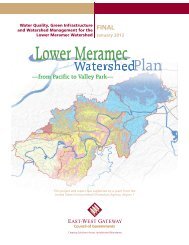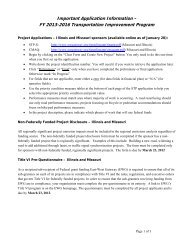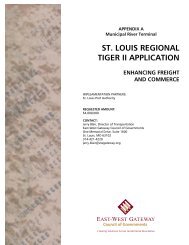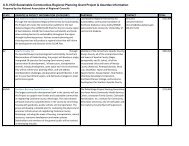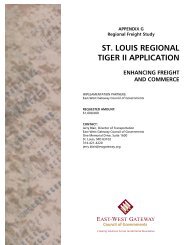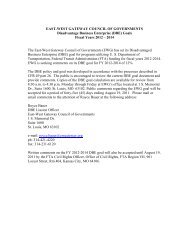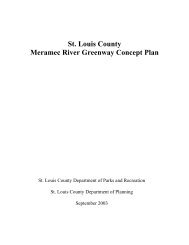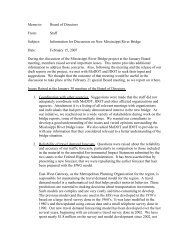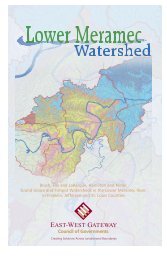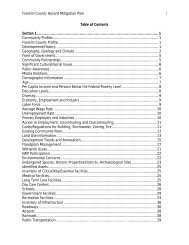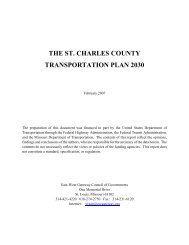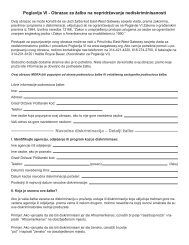Jefferson County - East-West Gateway Coordinating Council
Jefferson County - East-West Gateway Coordinating Council
Jefferson County - East-West Gateway Coordinating Council
You also want an ePaper? Increase the reach of your titles
YUMPU automatically turns print PDFs into web optimized ePapers that Google loves.
A Regional Overview All-Hazard Mitigation Plan 67<br />
Seasonal Pattern<br />
Tornadoes occur mostly during the spring and summer; the tornado season comes early in<br />
the south and later in the north because spring comes later in the year as one moves<br />
northward. Tornadoes and storms usually occur during the late afternoon and early<br />
evening, but they have been known to occur in every state in the United States, on any day<br />
of the year, and at any hour.<br />
Based on Table J38, in <strong>Jefferson</strong> <strong>County</strong>, most of the storms occurred in the month of April<br />
with 8 tornadoes. May had a total of 7 tornadoes, both June and July had 2, and<br />
September, October, November and December had 1 each per month.<br />
Speed of Onset And/Or Existing Warning Systems<br />
Tornadoes and other severe windstorms can occur instantly. The National Oceanic and<br />
Atmospheric Agency and other agencies (National Weather Service) have prioritized the<br />
research and understanding of the development of these types of storms in order to<br />
protect citizens and their property. As a result of this research, Doppler Radar was<br />
developed. Doppler Radar research was started in the 1950s by the Weather Radar<br />
Laboratory. At about the same time, research was beginning on severe storms through the<br />
National Severe Storms Project. In late 1963 the NSSL was formed to continue and<br />
enhance these two efforts. By the 1970's it was clear that Doppler Radar would greatly<br />
benefit the National Weather Service and could help to provide much-improved severe<br />
thunderstorm and tornado warnings.<br />
The new Radar, or NEXRAD for Next Generation Radar (officially WSR-88D), provides<br />
forecasters with a detailed look at storms through reflectivity and velocity displays.<br />
Reflectivity indicates rainfall or precipitation intensity and velocity displays the speed and<br />
direction of the winds within the storm.<br />
Through the Doppler Effect, a physical phenomenon marked by a change in frequency<br />
depending on the motion of an object toward or away from a point, the radar can give a<br />
picture of the winds within a storm. If, within a small area, high winds toward the radar<br />
are adjacent to high winds away from the radar, a circulation has developed and<br />
forecasters prepare to issue a warning. With this capability, tornado warning lead times<br />
have increased in the last 10 years from less than 5 minutes to nearly 12 minutes (NWS).<br />
Phased Array Radar - NSSL will soon begin adapting SPY-1 radar technology for use in<br />
spotting severe weather.<br />
The mission of the Severe Weather Warning Applications and Technology Transfer (SWAT)<br />
team is to develop severe weather warning applications and transfer them to users to<br />
enhance their capability to warn of severe weather. There are two focus groups within<br />
SWAT:



